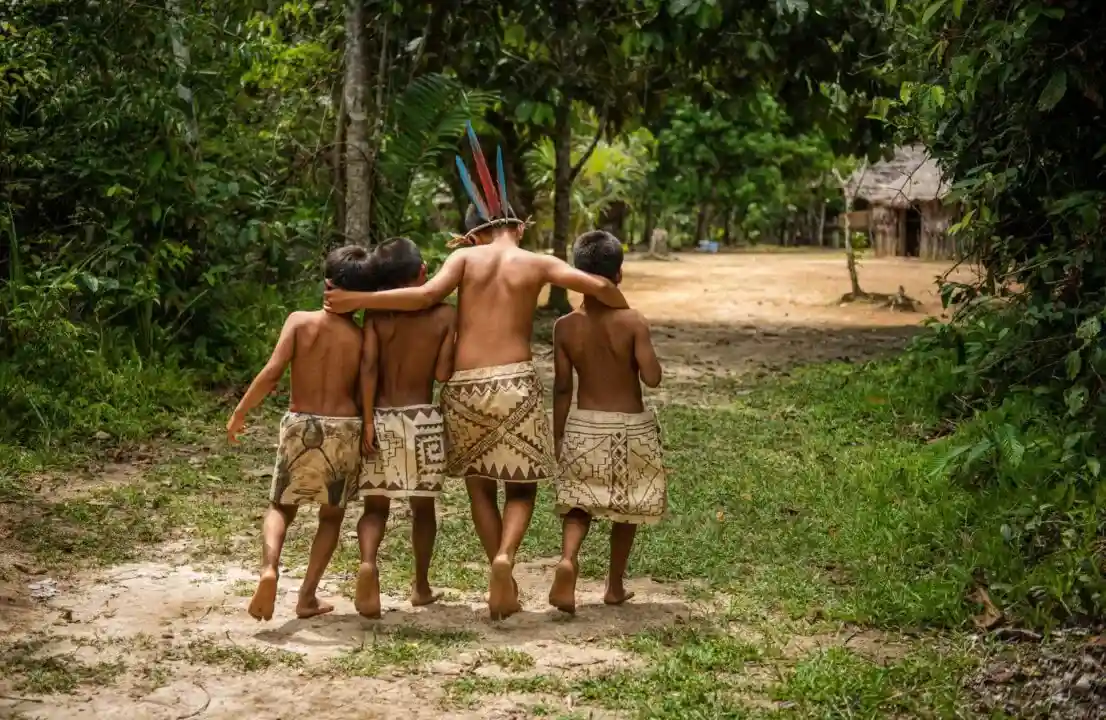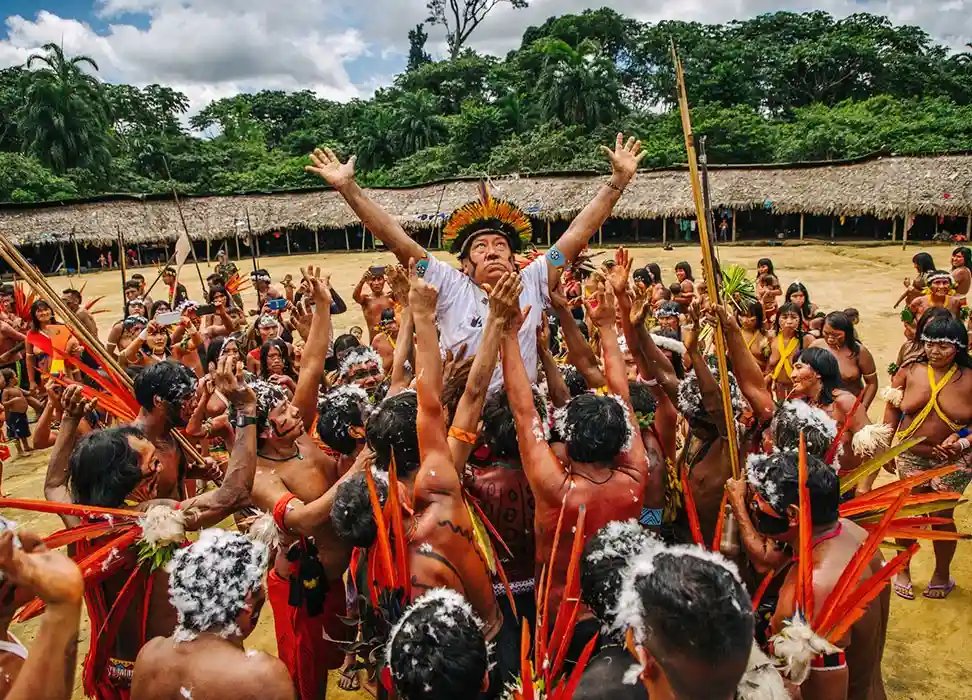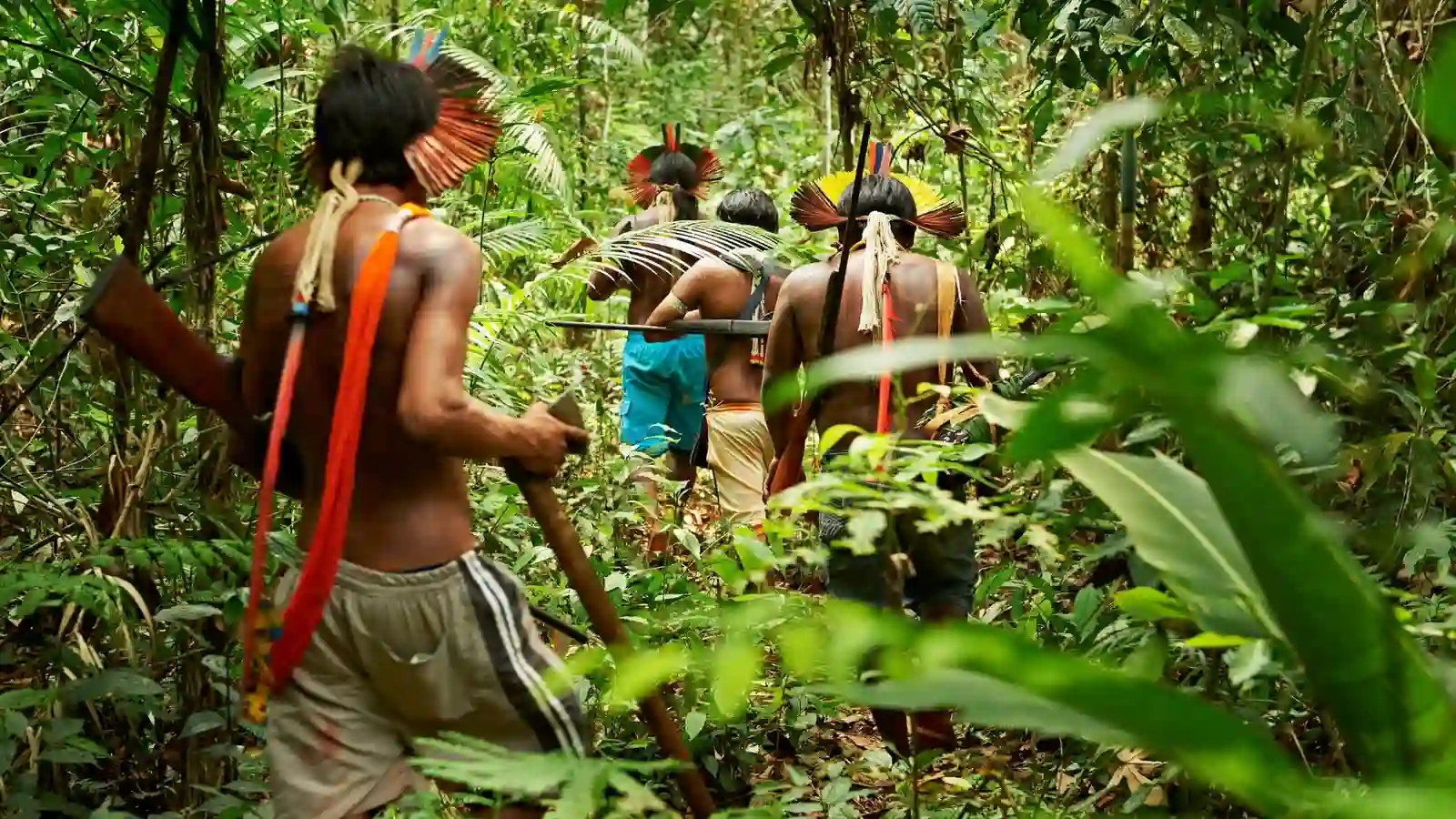The Peruvian Amazon tribes represent one of the most diverse collections of Indigenous peoples in the world, a living tapestry of cultures that have thrived in harmony with the rainforest for thousands of years. Far from being mere inhabitants of the jungle, they are its guardians and spiritual stewards, protecting vast territories while preserving traditional ways of life that hold invaluable knowledge about sustainability and environmental conservation.
Who are the Peruvian Amazon tribes?
In the Peruvian Amazon, 51 Indigenous peoples call the forest home—yep, fifty-one! Around 330,000 people live along rivers like the Ucayali, Marañón, and Madre de Dios. They speak 16 different language families: the Asháninka belong to the Arawak, the Shipibo-Conibo to the Pano, and the Awajún to the Jívaro.
These communities have been here for thousands of years, mastering skills you won’t find on YouTube: healing with plants, fishing without depleting the rivers, and farming while keeping the forest alive. For them, everything has a soul, from a towering tree to the river running past their village.
Their territories cover more than half of the Peruvian Amazon. That’s why they’re seen as the true guardians of the rainforest—one that not only sustains them but also helps keep the planet’s climate in check.
The role of the Peruvian Amazon tribes
The importance of the Peruvian Amazon tribes is like talking about the importance of trees in the Amazon. These communities have been protecting their environment for centuries, playing a decisive role that transcends their own territories. They are considered guardians of the forest because they live in approximately 60% of the Peruvian Amazon, and thanks to their traditional management practices, they have managed to curb deforestation more effectively than many areas protected by the State.
But their contribution doesn’t end there. Their knowledge of medicinal plants has opened the door to pharmaceutical discoveries that were previously thought impossible but now have a scientific basis. Their sustainable farming methods offer valuable insights into producing food without destroying the forest, even in a context of climate change.
Furthermore, their territories contain some of the most carbon-rich forests on the planet, making them key players in regulating the global climate. And, if that weren’t enough, they are cultural bridges: they keep alive ancestral languages, oral stories, and spiritual practices that teach us a different way of relating to nature. Their vision, based on interconnectedness, respect, and sustainability, is more relevant today than ever to address the environmental challenges we face.
You might be interested: Summer in Peru: 5 top destinations to visit

8 Peruvian Amazon tribes
You’ve probably heard of those Amazonian communities that have had no contact with the outside world, living without internet or even electricity. However, the Peruvian Amazon is home to more than 50 recognized indigenous communities, each with its own traditions, beliefs, and ways of life. In this section, you’ll learn about eight peruvian amazon tribes that stand out for their history, their myths, and their deep spiritual connection with nature. A cultural journey that reveals the richness of the rainforest beyond its biodiversity.
1. Asháninka
The Asháninka primarily live in the Junín, Pasco, Huánuco, and Ucayali regions. They are known for their deep connection with nature and their ongoing struggle to protect their lands from external threats. Their language belongs to the Arawak family, and despite facing numerous challenges throughout history, they have managed to preserve their traditions and way of life. The Asháninka combine agriculture with hunting and fishing, and their rituals and celebrations reflect a profound respect for the surrounding forest.
2. Shipibo-Conibo
The Shipibo-Conibo community is located along the Ucayali River in the Ucayali region. They are especially recognized for their textile art, known as “kené,” and for their extensive knowledge of traditional medicine, including the use of medicinal plants and ancestral ceremonies. Their language is Shipibo, and their culture revolves around harmony with the jungle. Additionally, their music and geometric designs are a living expression of their identity and spirituality.
3. Yagua
The Yagua inhabit the Amazon, Napo, Putumayo, and Yavari rivers. Although their population is relatively small, they maintain strong cultural traditions. They are experts in hunting and fishing, and their traditional clothing is made from carefully woven plant fibers. The Yagua have managed to preserve their language and customs despite modern influences, maintaining a lifestyle closely connected to the jungle’s resources and natural cycles.
4. Kichwa (Quichua)
The Kichwa live in regions such as Loreto, San Martín, and Ucayali. Their language, Kichwa, is part of the Quechua family, and the community has made significant progress in securing territorial rights. Their daily life combines traditional agricultural practices with community activities that strengthen cultural identity. The Kichwa also actively participate in jungle conservation and the transmission of ancestral knowledge to younger generations.
5. Matsés
The Matsés are found along the Peru-Brazil border near the Javari River. They are known for their self-sufficient lifestyle and deep knowledge of traditional medicine. The Matsés have preserved their language and customs despite external changes. Their relationship with the jungle is total: it provides food, medicine, and spiritual guidance. The Matsés are also skilled in navigating rivers and exploring the dense Amazon vegetation safely and efficiently.
6. Huitoto
The Huitoto live in the Loreto and Amazonas regions. Throughout their history, they have faced significant challenges, such as rubber exploitation and disease, but they have managed to keep their traditions alive. Their language, Huitoto, remains a core element of their cultural identity, and their daily life includes fishing, agriculture, and various rituals that strengthen community bonds and their relationship with nature.
7. Ticuna
The Ticuna live along the Amazon and Solimões rivers near the border with Brazil and Colombia. They are the largest tribe in the Brazilian Amazon region, although in Peru their population is around 7,000. Ticuna culture is rich in oral traditions, dances, music, and rituals that celebrate their connection to the rivers and the jungle. Their language and customs are passed down from generation to generation, allowing them to maintain their identity despite contact with modern society.
8. Cocama-Cocamilla
The Cocama-Cocamilla live along the Marañón, Ucayali, and Amazon rivers. Their life is closely tied to the river: fishing, river trade, and subsistence activities depend directly on its waters. This community has preserved its language and traditions, adapting to change without losing its identity. Interaction with the jungle and the river shapes not only their economy but also their culture, rituals, and worldview.
You might be interested: 40 Animals in the peruvian amazon

The cultural heritage of Amazon tribes in Peru
Have you ever heard about the Ayahuasca Retreat or the ceremonies performed by the Shipibo tribe? If the first thing that comes to your mind is exotic jungle parties, you should know that these traditions offer much more than cultural heritage. The Peruvian Amazon tribes have their own beliefs, arts, and customs that deserve our respect. From rituals to songs and handcrafted art, their creations are filled with ancestral knowledge passed down from generation to generation.
That’s why both the Peruvian Amazon and its tribes are considered part of Peru’s cultural heritage and must be protected. In this section, we’ll explore their identity in depth—from their culture to the spiritual beliefs that shape their way of life.
Traditional beliefs and spiritual practices
In many peruvian amazon tribes, nature is not treated as scenery. It is understood as a living presence with will, strength, and spirit. Rivers, ceiba trees, waterfalls, animals, and even ancestors are regarded as beings with their own lives and spiritual force. This way of seeing the world suggests that every human action—hunting, fishing, cutting wood, or building—has effects in the unseen realm. Out of respect, people make offerings of food, tobacco smoke, or songs, giving thanks to the spirits of rivers or mountains to keep the balance between humans and the forest.
The role of the curandero
Within this worldview, the curandero, or shaman, plays a central role. He is guide, healer, and mediator between the visible and invisible worlds. His practice blends profound botanical knowledge with the ability to listen to the spiritual. Before treating an illness, he may turn to plants or ancestors to understand the source of the problem, often seen as a disturbance in the natural order. To restore harmony, he relies on chants, blowing, fasting, medicinal baths, and in certain contexts, the use of master plants.
Ayahuasca ceremonies
Among the most recognized practices are ayahuasca ceremonies, usually held at night in communal spaces. The brew, made from the Banisteriopsis caapi vine and other companion plants, is used as a tool for vision, diagnosis, and learning. During the ritual, sacred chants—known as ícaros—mark the rhythm of the experience, guide the inner journey, and support the healing process.
Art, music, and craftsmanship
The Shipibo-Conibo embody the famous kené in their textiles, geometric designs that are not just ornaments but maps of ancestral knowledge that represent spiritual visions and connections to the cosmos. The Matsés paint their faces with lines and dots indicating their clan, age, or ceremonial moment, while the Asháninka dye their cushmas with colors obtained from forest bark and leaves.
The peruvian amazon tribes use flutes carved from animal bones, drums made from hollowed trunks, maracas filled with seeds that sound like rain on the leaves. Each instrument has its moment and purpose: the soft melodies of the flute to accompany ayahuasca ceremonies, the intense rhythms of the drum during healing rituals, the collective chants that narrate creation legends.
Women weave baskets from palm fibers, men carve masks representing water spirits, and everyone learns from childhood that creating with their hands is also a way of praying and keeping the memory of their ancestors alive.
Language and communication
Language is one of the strongest pillars of Amazonian identity. In the Peruvian Amazon alone, more than 40 Indigenous languages are still spoken, grouped into around 15 linguistic families. Each one carries a different way of naming the forest, describing its animals, and relating to the spiritual world.
Among the most widely spoken are Asháninka (from the Arawak family), with tens of thousands of speakers in central Peru; Shipibo-Conibo (Pano family), known for the richness of its oral tradition and ritual songs; and Awajún (Jivaroan family), spoken in the northern Amazon. Other communities, like the Yagua, Cocama-Cocamilla, Ticuna, or Huitoto, keep alive smaller languages that are equally rich in ecological and cultural knowledge.
Many communities today are bilingual: they use Spanish to interact with the outside world, but at home and in rituals their native languages remain essential. These languages are not just tools for daily communication—they are living archives that preserve myths, ecological wisdom, and histories passed down for centuries.
Uncontacted tribes Peru
Peru is home to an estimated 15 groups of Indigenous peoples who maintain minimal or no contact with the outside world, representing one of the largest populations of uncontacted tribes in the world. These communities, located primarily in remote areas of the central and southeastern Amazon, have opted for isolation as a survival strategy, often due to historical traumas of disease, violence, or exploitation.
This is why the Peruvian government officially recognizes these groups’ rights to remain uncontacted and has established territorial reserves to protect them from outside intrusion, so it’s not easy to visit. The largest of these is the Madre de Dios Territorial Reserve, which protects several uncontacted groups in the southeastern Amazon near the Brazilian border.
You might be interested: 15 Traditional food in Peru

How to visit the Amazonian tribes?
To visit the peruvian amazon tribes, you must first reach the main cities. Flights from Lima to Iquitos cost from USD 57 (S/ 213), while to Pucallpa from USD 54 (S/ 200). Between Amazonian cities, flights from Iquitos to Pucallpa cost from $83. You can also fly to Tarapoto (from USD 54) and then take land and river transportation.
Once in these cities, you will need to book tours with local operators who work directly with the communities. Basic guided boat tours cost from S/ 50 per person, but community-based tourism experiences are more expensive. For the Pacaya Samiria Reserve, prices start from 600 soles per day for one person (approximately $163/€149) with all services included, or 350 soles per person for two. These costs include land and river transportation, entrance fees, full board, accommodations, and excursions.
Recommendations for your trip
- The Pacaya Samiria National Reserve is one of the best places for community-based tourism, home to the Cocama-Cocamilla and Shipibo-Conibo communities. You can also visit the Ucayali River for the Shipibo-Conibo, or the Satipo region for the Asháninka. From Pucallpa, you can easily access the Shipibo-Conibo communities of the Ucayali, while Iquitos connects you to the Pacaya Samiria area and the Marañón.
- Look for agencies that have direct agreements with the communities, such as those certified by the Ministry of Foreign Trade and Tourism. Many communities have their own tourism associations, such as the Community Tourism Network of the Peruvian Amazon. Avoid operators that don’t clearly show how they benefit the communities or that promise “exotic” experiences without appropriate cultural context.
- Bring high-concentration insect repellent, sunscreen, long-sleeved clothing in neutral colors, rubber boots, a headlamp with extra batteries, and basic medications, including anti-diarrheal medications. Yellow fever vaccinations are mandatory. Respect the photography rules of each community and never photograph sacred ceremonies without explicit permission. Be prepared for rustic conditions: latrines, boiled river water, and limited electricity provided by generators.
Conclusion about the Peruvian Amazon tribes
The indigenous tribes of the Amazon are sophisticated societies with complex knowledge systems, sustainable technologies, and spiritual traditions that offer essential perspectives for addressing some of humanity’s greatest challenges, including climate change, biodiversity loss, and sustainable development. So if you decide to visit them, remember to be respectful of their traditions and customs, because when you travel to the Amazon, you are a guest of Mother Nature.



